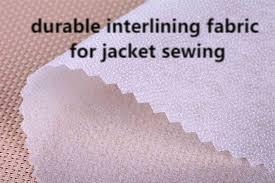In contemporary apparel production, the hidden layer referred to as Interlining quietly determines how a garment drapes and endures; skilled makers rely on Interlining to add shape, reinforce edges, and ensure a consistent finish across production runs. Although seldom seen by customers, this internal component influences comfort, longevity, and the perceived quality of everything from shirts to outerwear. This article explores material choices, application techniques, production implications, sustainability trends, and practical guidance for designers and manufacturers.
Material Choices and Functional Tradeoffs
Support layers are available in woven, nonwoven, and knitted forms, each bringing distinct mechanical behavior. Woven variants often offer crispness and memory that benefit collars and structured garments, while nonwoven types can provide smooth bonds and economical application for mass production. Knitted supports add stretch and recovery for more flexible designs. Selecting the right base requires balancing stiffness, weight, and breathability to match the outer fabric and intended wear conditions.
Application Methods and Manufacturing Impacts
How a support layer is applied affects both appearance and production flow. Fusible adhesives permit fast bonding with heat, streamlining assembly and producing uniform results ideal for large batches. Sewn-in techniques can be preferable for delicate fabric or garments requiring repeated laundering, since they avoid adhesive breakdown. Automated cutting and precise patterning reduce waste and improve repeatability, while manual methods still offer bespoke control for small-scale or high-end tailoring.
Performance Under Wear and Care
A well-integrated internal layer reduces stress at seams and prevents deformation in high-use zones. It should retain dimensional stability after repeated laundering and resist hardening or delamination over time. Designers should evaluate how the chosen combination behaves after pressing, washing, and extended wear. Real-world wear testing and careful wash-cycle simulations catch issues before full production, preventing costly recalls and protecting brand reputation.
Sustainability and End-of-Life Thinking
Environmental pressures are reshaping material selection and process choices. Recyclable fibers, reduced-chemistry adhesives, and options designed for easier disassembly help minimize lifecycle impact. Where possible, selecting supports that permit textile recycling or that come from recycled feedstocks supports circularity. Lifecycle assessments that include production energy, transport, and end-of-life disposal inform more responsible decisions and align with consumer expectations for transparency.
Prototyping and Quality Assurance Best Practices
Early-stage sampling with the intended final materials is essential. Mockups that use the exact support material reveal real drape and pressing behavior, while thermal and adhesion tests confirm compatibility with manufacturing conditions. Quality assurance protocols should monitor thickness variation, bond consistency, and wash stability. Clear specification documents and communication between design, sourcing, and production teams reduce rework and increase first-time-right rates.
Cross-Sector Applications Beyond Apparel
Support layers are not limited to clothing. They provide useful structure in accessories, home textiles, and specialized industrial fabrics. For instance, structured bags benefit from targeted reinforcement; curtains gain improved hang and opacity; protective textiles can include engineered layers for added insulation or barrier performance. Leveraging knowledge from adjacent sectors can inspire novel applications and new product lines.
Training, Documentation, and Supplier Collaboration
Effective use of support layers requires shared understanding across teams. Training for sewing operators and press technicians ensures correct handling, while detailed documentation of bonding temperatures, pressure settings, and acceptable tolerances prevents process drift. Close collaboration with material suppliers helps secure consistent deliveries and clarifies lead times, variability, and scale-up risks when transitioning from prototype to production.
Practical Selection Checklist for Designers
When choosing a support layer, consider fabric compatibility, intended care regimen, desired hand and drape, production method, and end-of-life goals. Run brief trials for pressing, washing, and wear, and document outcomes. Factor in future modifications: opting for slightly larger mounting space or modular construction can reduce the need for redesigns as styles evolve.
In summary, the internal support layer plays a decisive role in turning design intent into garments that look and perform as promised. Thoughtful selection, rigorous testing, and collaboration across the supply chain produce clothing that meets expectations for fit, durability, and sustainability. For more in-depth technical information and examples of types and uses, visit https://www.interlining-factory.com/news/what-is-interlining-types-applications-and-more.html



